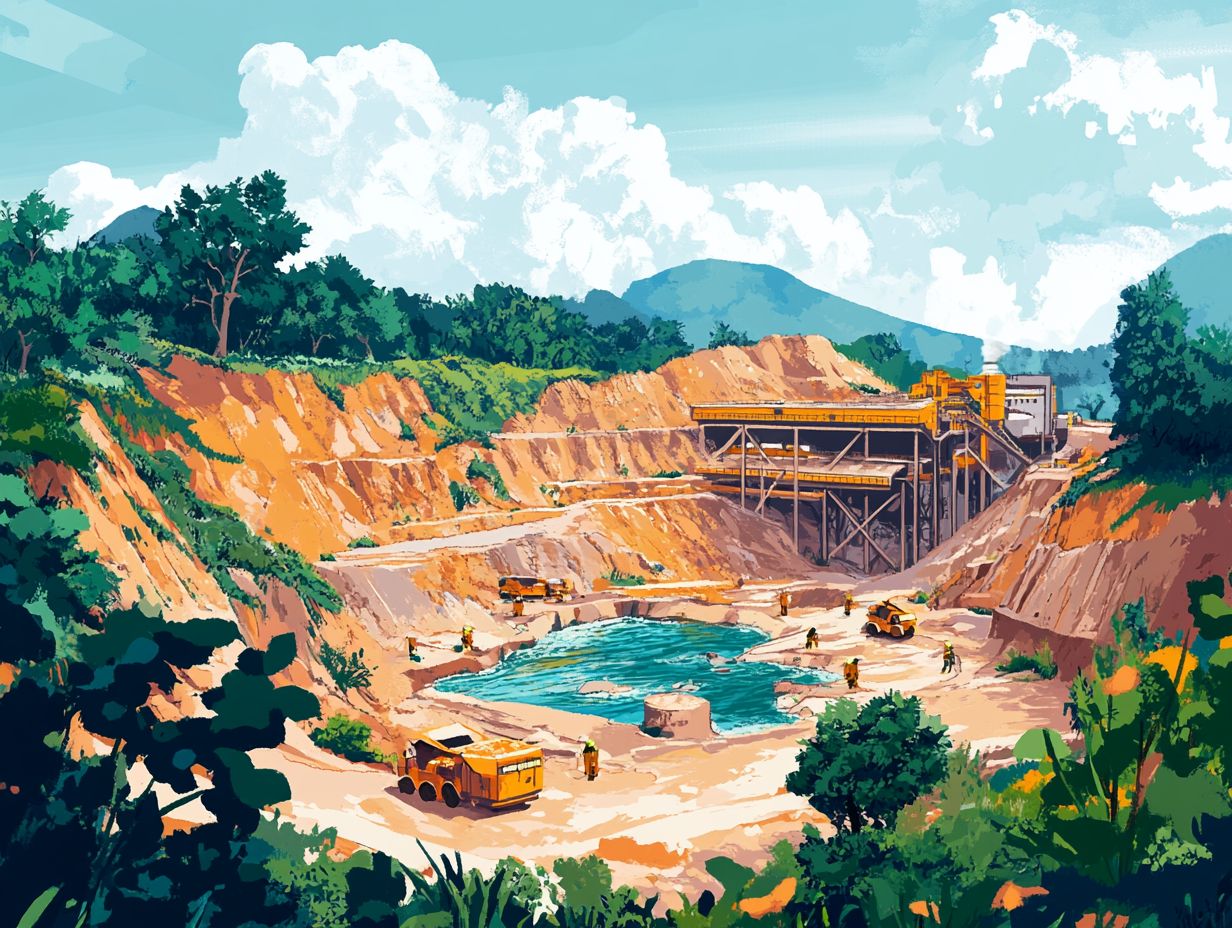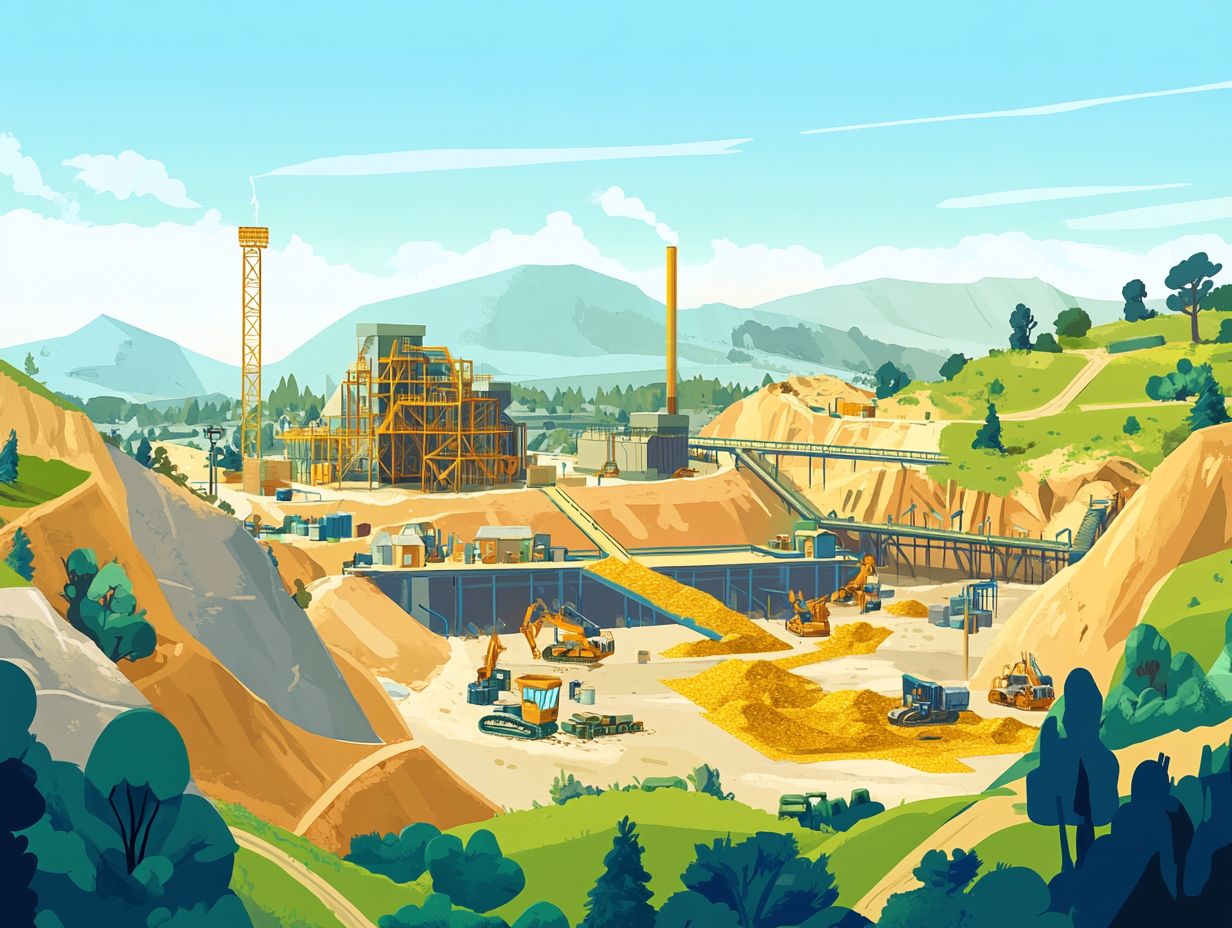The Rise of Sustainable Gold Mining Practices
Gold mining has historically been intertwined with both economic prospects and environmental challenges. Traditional methods often result in considerable ecological damage, underscoring the urgent need to seek sustainable alternatives that protect our planet while benefiting local communities.
This article delves into the evolution of gold mining, shedding light on conventional practices and their environmental repercussions. It emphasizes the critical necessity for sustainable approaches.
You ll discover practical examples of eco-friendly methods and the potential advantages and hurdles of implementing these techniques. This exploration offers valuable insights into the future of gold mining in our rapidly changing world.
Prepare to uncover the shift toward sustainable gold mining practices.
Contents
- Key Takeaways:
- Overview of Gold Mining Practices
- The Need for Sustainable Practices
- Sustainable Gold Mining Techniques
- Benefits of Sustainable Gold Mining
- Challenges and Obstacles
- Exciting Developments in Sustainable Gold Mining
- Frequently Asked Questions
- What is the meaning of sustainable gold mining?
- Why is there a rise in sustainable gold mining practices?
- How are companies implementing sustainable gold mining practices?
- What are the benefits of sustainable gold mining practices?
- Are there regulations in place for sustainable gold mining practices?
- What can individuals do to support the rise of sustainable gold mining practices?
Key Takeaways:

Sustainable gold mining practices minimize environmental harm. Techniques include renewable energy, responsible waste management, and community engagement.
Exciting opportunities await in the future of sustainable gold mining!
Overview of Gold Mining Practices
Gold mining practices have undergone remarkable evolution over the years. Today, the gold supply chain is under heightened scrutiny, with companies held accountable for their environmental impact and their engagement with local communities.
The demand for ethical gold mining continues to rise, as consumers increasingly seek responsible sourcing that promotes sustainability and economic stability for these communities. Various initiatives, such as the Responsible Gold Mining Principles established by the World Gold Council, guide these practices and elevate the integrity of the gold production process.
Traditional Methods and Environmental Impact
Traditional gold mining methods can significantly impact the environment. They often lead to deforestation and soil degradation as miners extract precious metals in ways that disrupt local ecosystems.
Small-scale mining frequently relies on hazardous techniques, such as the use of mercury, a toxic metal harmful to health and the environment. This not only contaminates nearby water sources but also poses serious health risks to the communities living in proximity.
The removal of trees and vegetation for mining purposes leads to a loss of biodiversity. It creates unstable soil conditions, resulting in erosion and further landscape degradation.
Efforts to reclaim disturbed lands often fall short. Inadequate restoration techniques can fail to restore the original quality of the topsoil, making it increasingly difficult for vegetation to reestablish itself and perpetuating a cycle of environmental harm.
The Need for Sustainable Practices
The urgency for sustainable practices in gold mining cannot be overstated. The harmful effects of traditional methods have ignited serious concerns regarding environmental assessments and the ethical sourcing of conflict-free gold.
Stakeholders ranging from local communities to gold mining companies are championing gold mining standards that encourage responsible sourcing and confront pressing environmental and social issues.
Environmental and Social Concerns
Environmental and social concerns surrounding gold mining present a complex tapestry of issues. You must consider ethical mining practices, renewable energy usage, and worker safety.
These concerns highlight the critical disparities in practices that lead to serious ecological harm, including deforestation, soil erosion, and water contamination from toxic mining chemicals. Labor conditions within the industry often raise red flags, with many workers enduring perilous environments devoid of adequate safety equipment or health protections.
To tackle these challenges, commit to ethical gold mining standards that prioritize fair wages and safe labor conditions. Embracing renewable energy initiatives helps reduce the carbon footprint associated with mining activities while fostering sustainable practices that safeguard the environment for generations to come.
Sustainable Gold Mining Techniques

Sustainable gold mining techniques stand out as essential alternatives to conventional practices.
These methods prioritize eco-friendly extraction processes, land reclamation, and innovative restoration strategies.
By minimizing environmental degradation, they not only protect the planet but also maximize resource efficiency. This ensures a more responsible approach to gold mining.
Examples of Sustainable Practices
Numerous examples of sustainable practices in gold mining exist, such as responsible sourcing programs and initiatives like Fairtrade Gold. These efforts prioritize financial stability for local communities while promoting ethical mining standards.
In addition to Fairtrade Gold, organizations like the Responsible Jewelry Council are making significant strides to ensure that gold is mined with minimal environmental impact and respects the rights of workers.
By implementing stringent criteria for ethical sourcing, they empower you to make informed decisions while actively supporting local economies.
Community engagement initiatives, such as training programs for artisanal miners, help local miners gain skills, improving their job prospects and community well-being.
These efforts contribute to sustainable practices and cultivate a sense of ownership and pride among local communities, fostering long-term financial stability and reducing the industry’s negative social footprint.
Benefits of Sustainable Gold Mining
Embracing sustainable gold mining offers benefits that go far beyond simply adhering to regulations.
It encompasses a multitude of positive impacts on both communities and the environment, elevating worker safety and fostering a sense of social responsibility.
Positive Impact on Communities and Environment
Sustainable gold mining practices can significantly enhance both communities and the environment. They promote community engagement and align with responsible methods that benefit all stakeholders involved.
By prioritizing responsible extraction techniques, you can create meaningful job opportunities and uplift local economies.
Additionally, investing in vital infrastructure such as schools and healthcare facilities can transform communities.
Mining companies that champion community development often collaborate with local organizations to establish vocational training programs, empowering residents to acquire valuable skills.
Embracing environmentally friendly operations helps reduce pollution and safeguards surrounding ecosystems, fostering biodiversity.
A remarkable example is miners who team up with local governments to plant trees again in areas affected by mining activities, thereby revitalizing habitats and enriching community well-being.
Challenges and Obstacles
Even with the increasing focus on sustainable gold mining, you ll find that numerous challenges and obstacles still impede the broader adoption of responsible sourcing practices among gold mining companies.
This often leads to ongoing environmental impacts and social inequities that cannot be overlooked.
Overcoming the Challenges of Sustainable Gold Mining

Barriers to implementing sustainable practices in gold mining often arise from the financial stability concerns that companies face. They frequently prioritize short-term profits over ethical standards, such as ensuring gold is mined without funding violence or conflict.
Stakeholders grapple with significant financial constraints, which can hinder their ability to invest in eco-friendly technologies or practices.
The relentless pressure to remain competitive in a volatile market often leads companies to overlook sustainable methods, with immediate cost reductions taking center stage.
Regulatory challenges add another layer of complexity. Many mining enterprises navigate a tangled web of local and international regulations that can lack clarity or enforcement.
This uncertainty may deter companies from fully committing to long-term sustainable initiatives, ultimately stalling progress in the transition to responsible mining practices.
Exciting Developments in Sustainable Gold Mining
The future of sustainable gold mining looks incredibly promising. Predictions suggest a significant shift toward more responsible sourcing and practices that actively reduce environmental impact.
This transformation is fueled by rising consumer demand for ethical gold, creating a compelling landscape for change in the industry.
Predictions and Potential Growth
Predictions indicate a compelling opportunity for growth through sustainable practices and community engagement initiatives. Stakeholders increasingly acknowledge the significance of ethical gold mining.
This transformation comes from the growing global demand for responsibly sourced materials, driving companies to emphasize caring for the environment and social responsibility.
As major players in the industry adopt more transparent supply chains, smaller enterprises are encouraged to embrace similar practices, creating a ripple effect throughout the sector.
This renewed focus aims to reduce the ecological footprint of mining operations while cultivating meaningful dialogue between miners and local communities. It’s essential that the voices of those most affected are genuinely heard.
With advancements in eco-friendly extraction techniques and collaborative efforts to bolster local economies, the potential for sustainable gold mining emerges as essential for the industry’s future.
Frequently Asked Questions
What is the meaning of sustainable gold mining?
Sustainable gold mining refers to extracting gold in a way that minimizes its impact on the environment, society, and economy. It involves using responsible mining techniques that prioritize the well-being of people and the planet.
Why is there a rise in sustainable gold mining practices?

The rise in sustainable gold mining practices responds to the growing awareness and concern over the negative impacts of traditional gold mining methods, including deforestation, water pollution, and human rights abuses.
How are companies implementing sustainable gold mining practices?
Companies are adopting sustainable gold mining practices by using eco-friendly mining techniques, reducing their carbon footprint, and promoting responsible sourcing of materials. They prioritize the safety and well-being of their workers and local communities.
What are the benefits of sustainable gold mining practices?
Sustainable gold mining practices have multiple benefits. These include reduced environmental impact, improved social responsibility, and increased economic stability. They promote the long-term sustainability of the mining industry and can attract ethical investors and customers.
Are there regulations in place for sustainable gold mining practices?
Yes, there are regulations for sustainable gold mining practices. These include international standards such as the Responsible Gold Mining Principles, as well as national laws and regulations that promote sustainable mining practices and hold companies accountable for their actions.
What can individuals do to support the rise of sustainable gold mining practices?
Individuals can support the rise of sustainable gold mining practices by educating themselves on the issue, choosing to purchase responsibly sourced gold, and supporting companies that prioritize sustainability. They can also advocate for stronger regulations and policies that promote sustainable mining practices.
Join the movement for sustainable gold mining by making informed choices today!



